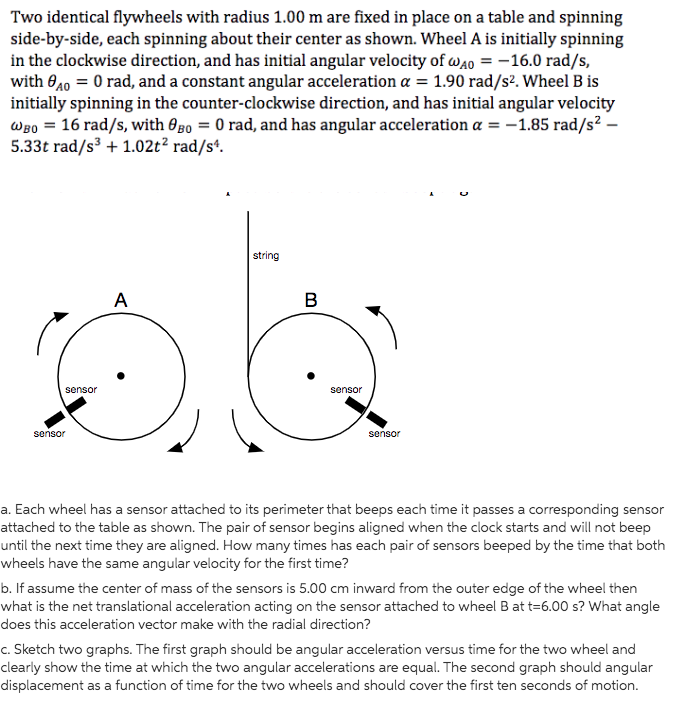Two identical flywheels with radius 1.00 m are fixed in place on a table and spinning side-by-side, each spinning about their center as shown. Wheel A is initially spinning in the clockwise direction, and has initial angular velocity of wao = -16.0 rad/s, with 010 = 0 rad, and a constant angular acceleration a = 1.90 rad/s². Wheel B is initially spinning in the counter-clockwise direction, and has initial angular velocity Wgo = 16 rad/s, with 0g0 = 0 rad, and has angular acceleration a = –1.85 rad/s² – 5.33t rad/s³ + 1.02t² rad/s*. string А в sensor sensor sensor sensor . Each wheel has a sensor attached to its perimeter that beeps each time it passes a corresponding sensor attached to the table as shown. The pair of sensor begins aligned when the clock starts and will not beep until the next time they are aligned. How many times has each pair of sensors beeped by the time that both vheels have the same angular velocity for the first time? o. If assume the center of mass of the sensors is 5.00 cm inward from the outer edge of the wheel then vhat is the net translational acceleration acting on the sensor attached to wheel B at t=6.00 s? What angle does this acceleration vector make with the radial direction? . Sketch two graphs. The first graph should be angular acceleration versus time for the two wheel and learly show the time at which the two angular accelerations are equal. The second graph should angular displacement as a function of time for the two wheels and should cover the first ten seconds of motion.
Two identical flywheels with radius 1.00 m are fixed in place on a table and spinning side-by-side, each spinning about their center as shown. Wheel A is initially spinning in the clockwise direction, and has initial angular velocity of wao = -16.0 rad/s, with 010 = 0 rad, and a constant angular acceleration a = 1.90 rad/s². Wheel B is initially spinning in the counter-clockwise direction, and has initial angular velocity Wgo = 16 rad/s, with 0g0 = 0 rad, and has angular acceleration a = –1.85 rad/s² – 5.33t rad/s³ + 1.02t² rad/s*. string А в sensor sensor sensor sensor . Each wheel has a sensor attached to its perimeter that beeps each time it passes a corresponding sensor attached to the table as shown. The pair of sensor begins aligned when the clock starts and will not beep until the next time they are aligned. How many times has each pair of sensors beeped by the time that both vheels have the same angular velocity for the first time? o. If assume the center of mass of the sensors is 5.00 cm inward from the outer edge of the wheel then vhat is the net translational acceleration acting on the sensor attached to wheel B at t=6.00 s? What angle does this acceleration vector make with the radial direction? . Sketch two graphs. The first graph should be angular acceleration versus time for the two wheel and learly show the time at which the two angular accelerations are equal. The second graph should angular displacement as a function of time for the two wheels and should cover the first ten seconds of motion.
Related questions
Question

Transcribed Image Text:Two identical flywheels with radius 1.00 m are fixed in place on a table and spinning
side-by-side, each spinning about their center as shown. Wheel A is initially spinning
in the clockwise direction, and has initial angular velocity of wao = -16.0 rad/s,
with 040 = 0 rad, and a constant angular acceleration a = 1.90 rad/s². Wheel B is
initially spinning in the counter-clockwise direction, and has initial angular velocity
Wgo = 16 rad/s, with 0go = 0 rad, and has angular acceleration a = -1.85 rad/s² –
5.33t rad/s + 1.02t² rad/s*.
string
A
sensor
sensor
sensor
sensor
a. Each wheel has a sensor attached to its perimeter that beeps each time it passes a corresponding sensor
attached to the table as shown. The pair of sensor begins aligned when the clock starts and will not beep
until the next time they are aligned. How many times has each pair of sensors beeped by the time that both
wheels have the same angular velocity for the first time?
b. If assume the center of mass of the sensors is 5.00 cm inward from the outer edge of the wheel then
what is the net translational acceleration acting on the sensor attached to wheel B at t=6.00 s? What angle
does this acceleration vector make with the radial direction?
c. Sketch two graphs. The first graph should be angular acceleration versus time for the two wheel and
clearly show the time at which the two angular accelerations are equal. The second graph should angular
displacement as a function of time for the two wheels and should cover the first ten seconds of motion.
Expert Solution
This question has been solved!
Explore an expertly crafted, step-by-step solution for a thorough understanding of key concepts.
Step by step
Solved in 6 steps with 10 images
